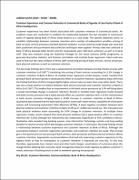| dc.description.abstract | LUBEGA JULIUS (2014 – M102 – 20038)
Customer Experience and Customer Retention in Commercial Banks of Uganda: A Case Study of Bank of Africa Headquarters.
Customer experience has been closely associated with customer retention in commercial banks. An academic study was conducted to establish the relationship between the two variables in commercial banks of Uganda taking Bank of Africa (main branch) as a case study. The specific objectives were: to establish relationships between customer retention and a number of independent variables; pricing of bank services, service processes and bank physical evidence. A cross sectional study design was used and both qualitative and quantitative data collection techniques were applied. Primary data was collected at Bank of Africa Kampala Main branch and the respondents were 200 bank customers as well as 6 bank staff. Data was analysed using the Statistical Package for the Social Sciences (SPSS) programme to generate descriptive statistics, and Pearson correlations and multiple linear regression. Likert scale was used to find out the views of Bank of Africa staff concerning pricing of bank services, service processes, bank physical evidence as well as customer retention.
The key study findings were: there was a weak positive correlation between pricing of bank services with customer retention (r=0.249**) translating into pricing of bank services accounting for 6.2% change in customer retention at Bank of Africa. At multiple linear regression model analysis, results revealed that pricing of bank services had also a weak positive effect on customer retention. Qualitative data confirmed the finding that Bank of Africa charged slightly higher interest rates on loans than some other banks. There was also a weak positive correlation between bank service processes and customer retention at Bank of Africa (r=0.156*). This implies that an improvement in the bank service processes by 2.4% will bring about a similar percentage change in customer retention. Results in multiple linear regression model showed that bank service processes had a weak positive effect on customer retention with a 10.4% improvement in bank service processes bringing about a 10.4% increase in customer retention at Bank of Africa. Qualitative data showed that the bank had focused on more staff, faster service, availability of information notices and functioning Automated Teller Machines (ATMs). A weak negative correlation between bank physical evidence and customer retention at Bank of Africa (r=-0.066) was found out. This translates into bank physical evidence alone accounting for 0.4% change in customer retention. At multiple linear regression model, results showed that bank physical evidence had a weak positive effect on customer retention (B= 0.025) although the relationship was statistically insignificant at 95% confidence interval. Qualitative data revealed long banking queues, slow Information Technology systems and long waiting duration to receive services which discourages customer retention. In conclusion, the study findings reveal a relationship between customer experience and customer retention at Bank of Africa. Although the associations between customer experience parameters and customer retention are weak, they at least give a hint particularly on how pricing of bank services, bank processes and bank physical evidence affects customer retention. Appropriate recommendations that look into improving customer experience to the highest levels so that its contribution to customer retention is improved are very key. To this end, therefore, appropriate loan interest rates and other bank charges, sensitisation of customers about the charges before debiting their accounts, bank management board to meet regularly to address customer‟s needs, extension of banking hours as well as weekend opening are proposed.
Key Words: Customer Retention, Commercial Banks, Bank of Africa Headquarters. | en_US |


